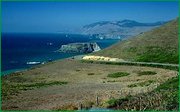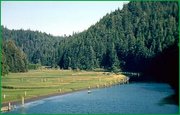Fort Bragg Terraces (Bailey)
Contents
Lithology and Stratigraphy
This subsection contains predominantly clastic Pleistocene marine deposits and Franciscan marine sedimentary rocks of the Coastal Belt.
Geomorphology
This subsection is on an elevated coastal plain with several levels of terraces. The terraces are nearly level, but they are deeply dissected to expose Franciscan rocks in ravines. The uppermost terrace is about 800 feet above mean sea-level. Ocean currents, waves, and wind are active along the outer edges of the terraces. Fluvial erosion is the main geomorphic process on the terraces, although eolian erosion and deposition has been active in the past. Mass wasting is another process that is active on steep ravine slopes.
Soils
The soils on the terraces are mostly Typic and Plinthic Tropohumults and Dystropepts. Those in Franciscan rock terrain are mostly Ultic Hapudalfs. Less extensive, but notable for the “pygmy forest” on them, are Albaqults and Duraquods. The soil temperature regimes are isomesic. Soil moisture regimes are mostly udic with some aquic.
Vegetation
The predominant plant community is Redwood series. Grand fir and western hemlock series also occur. Bishop pine series and Pygmy cypress series occur on Albaqults and Duraquods. Red alder series is common in riparian areas.
Characteristic series by lifeform include:
Climate
The mean annual precipitation is about 40 to 50 inches; there is considerable summer fog. Mean annual temperature is about 50° to 53° F, and there is less than 14° F difference between lowest and highest monthly means. The mean freeze-free period is about 300 days.
Surface Water
Water runs off of the terraces slowly and the broader terraces are poorly drained between ravines that drain the edges of the terraces more rapidly.
Return to Northern California Coast

